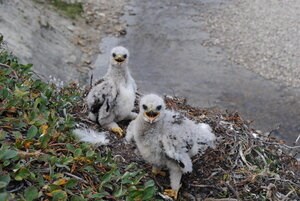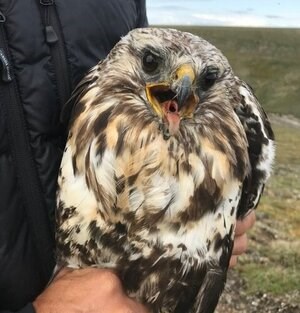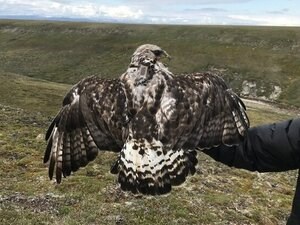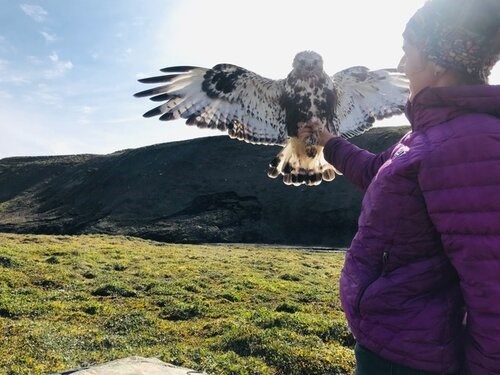Inside the Arctic Blind
Posted on in In the Field by Rebecca McCabe, PhD Candidate McGill University, Hawk Mountain Graduate Student

On the frigid tundra, the only thing between myself and the hard ground is a cushioned seat; my feet are propped up against a millions-of-years-old rock. The camouflaged blind is conspicuous against the treeless landscape but allows me to watch the birds without disturbing them. I stare through the small window, binoculars in hand, at an open cliff face where a rough-legged hawk sits about halfway down on a grassy green ledge.
Four young sit inside the nest cup, calling out to their parents “feed me, feed me.” At 10:15 the adult female swoops in and lands on the perch above the stick nest where we have our trap. She hops down to attend to her young before flying off. Less than five minutes pass before she returns. The chicks stand up and start calling excitedly. Finally, food has arrived! Their mother pulls apart the prey with her sharp bill, and within 30 seconds, it disappears into the crops of a few hungry hawks. She then returns to our baited trap but once again evades capture, and after a few nibbles she leaves to a higher perch, where she dutifully watches over her young.

We endure over an hour of silence until the chatter of the young hawks begins once more. The female is back on the trap! For the next twenty minutes or so, I watch, hardly blinking as she climbs and hops back and forth from the trap to the nest, feeding small bits of prey to her chicks. With each leap I hold my breath, waiting for her to become trapped. Finally, after a dozen trips, her leg gets caught in a noose. I quickly radio to JF, “We got a bird!” and I leap from my seat, open the blind door, and run down the hill towards the base of the cliff. I cross the river and quickly climb ten meters up the crumbling, vertical cliff to retrieve the female who lies calmly on the ground with a noose line caught around three of her toes. I secure her wings with one hand and grab her legs with the other. Next, I carefully place her inside of a cloth bag and remove the noose from her toes, so I can head back down the cliff and up the valley to meet Dr. JF Therrien, Hawk Mountain’s Senior Scientist.

The stunning bird weighed over 1.1 kilograms and was placid as we measured, banded, and affixed a backpack transmitter. JF held the female and guided me as I slid the harness over her head and fitted the backpack to her body. We snapped a few photos, admired her beauty, and with great big smiles on our faces, we released her back onto the open tundra.
The data collected from this female and the other rough-legged hawks trapped on Bylot Island, Nunavut will help us better understand the breeding dispersal, migratory movements and survival rate of North America’s largest buteo. To learn more or to support this important research, click here or contact Dr. JF Therrien ([email protected]; 570-943-3411 x104).
Special thanks to Hawk Mountain’s supporters, the W. Garfield Weston Foundation, the NSERC CREATE-EI program, the Polar Continental Shelf Project, Université Laval, and Parks Canada for supporting this study in the high-Arctic.
